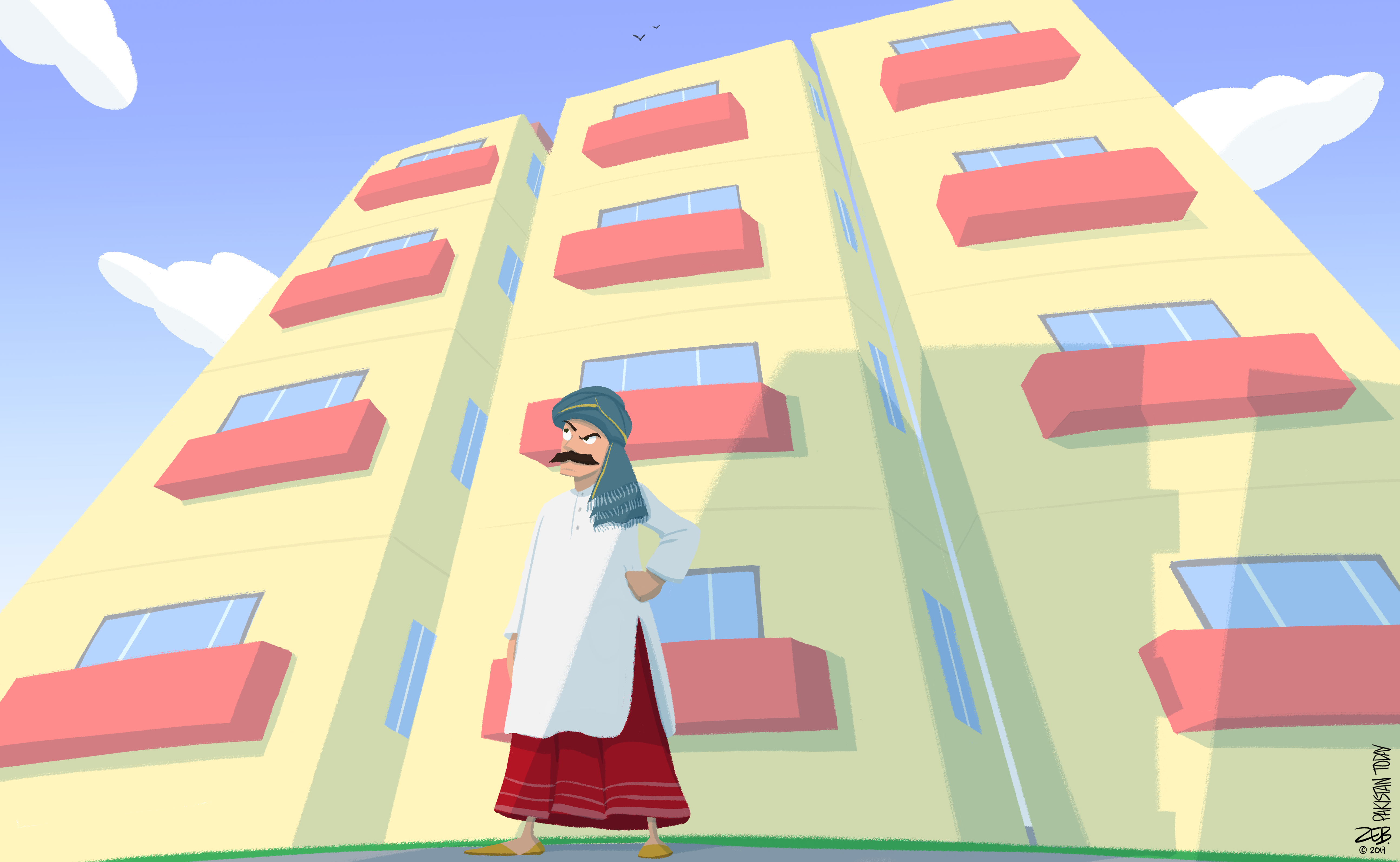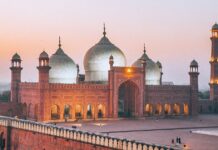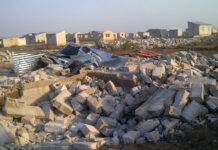Despite the population of Lahore doubling over the past decade or so, the ever increasing sprawl and spread of it–which now extends from Shahdara at the banks of Ravi to Manga Mandi–makes sure that Lahore doesn’t make it to the list of the most densely populated cities of the world.
With continued increase anticipated in the city’s population, demand for housing units is also expected to remain high. However, the city’s expansion at its periphery all round, save where the border is, means increased distances, longer commute time and fuel cost for the professionals, workers, students who have to make a beeline to Gulberg, The Mall and other central city locations.
LDA doubles the height level
With close-to-city-centre land for housing hard to come by, and prohibitively expensive to boot, the Lahore Development Authority (LDA) has recently almost doubled the permissible height limits for residential apartment buildings, almost doubling it from 45 ft. (ground plus three floors) to 80 ft. (ground plus six floors).
As a consequence, developers have stormed in to gain a piece of this newly available pie, and many apartment buildings and luxury vertical housing projects have sprung up, with seven projects already in different stages of construction, at least another 10 under consideration for regulatory approval and an expected 30 more in the planning stages.
Most of these projects plan to provide luxury housing to the upper strata of the society. And most of these are located in upscale neighbourhoods like Gulberg, and contain high-end amenities including private security guards, elevators, gym, swimming pool, 24 hours backup electricity, etc.

For the rich and nouveau riche
So who is the main taker of these apartments? So far, the trend reflects that it won’t be the locals of the city, rather overseas Pakistanis or people from other cities moving to Lahore for business or a job.
Till now the market response from local Lahoris at best is tepid, with different stakeholders having divergent views with regard to it becoming the fad or fading out.
Profit reached out to constructors, developers and LDA to find out what these extravagant projects are all about.
The target market
First and foremost, almost all industry players interviewed proffered that overseas Pakistanis were the predominant amongst the patrons, with most of the rest being from other cities desirous of having a pad at Lahore, along with students from other cities coming to Lahore to study, newly married couples and foreign-returned folks.
The expat Pakistanis are not living here, but they wish to have a home of their own whenever they come to visit. According to Umer, they want to have a neat, clean, secure and fully functional place to return to instead of a house where either the air conditioners are not working properly, the electricity is out or something else is not operational.
Then there are students from wealthy families residing in other cities. Their parents buy such luxury apartments not only to give their children a fancy and secure place to stay while they go to college and university but also to have a place of their own to stay when they visit rather than paying to stay at a hotel or staying at a relative or friend’s place.
Another client base are people who have returned from abroad after having experienced the apartment living culture there for a few years but have had to move back. For them to suddenly come back and adapt to the conventional way of living in houses in Lahore is not easy so a fully serviced apartment like the one they’ve recently left is quite appealing.
In addition to this those non-resident foreign professionals working at various multinationals in Lahore are also prospective buyers. Multinationals can rent out or simply buy multiple apartments for their employees’ accommodation.
The influx of foreign based human capital is also bound to increase in the coming years given the huge investment being made by China with regards to China-Pak Economic Corridor (CPEC).
Reportedly already there is an increase in demand for lodging of Chinese nationals deputed here under the CPEC mission. For them the prospect of apartment living will be quite attractive especially the secured living aspect of it, which is currently missing from Lahore altogether.

Usman explained that there are also some locals who live in big houses but when their sons and daughters get married, they buy them apartments instead of a separate house. Some even make this investment for their unmarried children for when their kids tie the knot and need a separate, private place.
That clearly reflects that at least for now there is perceptible aversion amongst the Lahorites for apartment living unless they have experienced apartment living or are saving on the hassle of buying or building houses for their ‘just-married’ kids. The prevalent sentiment is that “residence should be on firm ground, not in the air – literally.”
Empire Holdings Director Umer Elahi (Opus Luxury Residences), Hyde Parks (by the Hospitality Inn) Marketing Manager Usman Nawaz, and DCC Developers CEO Shahnawaz Durrani (Address 73) all agree that majority of the apartments they have sold were taken by the Pakistani expats, or young couples seeking to live an independent, efficient and comfortable environment.
LDA Director Architect Arif Bashir seems to have more faith in his city than the sales figures suggest, “Lahore has expanded horizontally by a great deal, that has made housing possible but people have to commute a lot. So on the face of it, the apartments will become the new trend. Islamabad and Karachi have already moved to apartment-living, and Lahore too is likely to join them.”
Cost efficient in the long run
These ‘luxury apartments’ are anything but a low-cost affair. Yet, the developers insist these are cost effective when it comes today-to-day expenses. Not only all the amenities like gymnasium, swimming pool, residents lounge, rooftop garden, and in some cases football field, etc. are all provided within the apartment block. And built in are lower utility bills, lower cost of domestic helpers and above all lower fuel costs due to proximity to the main commercial areas in the city.
People, Usman says, especially those living overseas or those who might have to leave the place vacant for a given time period regularly, also prefer security over anything else. “To the buyers it is a huge incentive to be able to lock their apartments and come back after months to find everything as they had left it.”
Umer shared this sentiment and added, “Until we are managing the building, or say until all of the apartments are sold out, we are also offering services to manage the apartments themselves. The owners can drop their keys with us and we will get it cleaned and managed in their absence.”
Tackling the widespread fears of natural disasters, like earthquakes, these apartment builders said that they have taken the necessary precautions to strengthen the buildings and on top of that they have also transferred the ownership of land to its customers in respect to their investments.

Builders enumerate slew of benefits
“We will transfer the ownership of land on which the building is situated to the investors in proportion of their investments in the whole project. For instance a three bedroom apartment owner will gain a bigger piece than a two bedroom apartment owner, but at the end of the day the residents of the project will be the owners of the whole area,” said Usman.
Umer reassured that all necessary measures were thoroughly incorporated when the structure of the building was being designed to make it fireproof and resistant to earthquakes.
In jest, he asked, “Do people ask these questions when they are buying a house on the ground, because all these things are equally relevant there?” He added, “So it is not as much a factor in people’s decision-making when they have to choose between a house and an apartment, rather the facilities they gain and the peace of mind they have even if they are not there all the time is what tilts the balance in their choice to invest.”
The industry players are also convinced that the housing opportunity they are providing in the cost they are offering is impossible to gain in a 10 marla house for instance, all things considered. Hammering at its advantages, Umer said, “You might get the simple cement structure or basic facilities like air conditioning in the same cost as you can have for a two bedroom apartment, but the amenities and the central location that we are offering is not possible in that budget.”
Indeed, a major chunk of the new projects coming up are located within Gulberg, save one in Garden Town called Florets, and Florets too have a different story to tell.
While projects like Empire Holdings and Hyde Parks are positioning themselves for the elite with upscale pricing that goes up to Rs25,000 per square feet, Florets seems to have downscaled to attract a wider range.
Florets Marketing Manager Faisal Azeem informed that majority of their sales have been made to the customers already residing in or near Garden Town. “For them the location was not a big factor but the luxuries that they would receive without any cost top up brought them towards this project.”
He had an added detail to share saying that most of his customers were doctors by profession, which he meant as an explanation to the higher SECs that the project was targeting.

Viable investment for the apartment owner?
Regarding the location of these luxury apartment buildings LDA Director Architect Arif Bashir said that there was no restriction on these projects to be focused on any one area. But since these were all done by private builders and developers, it was not LDA’s discretion to choose the location. He, however, backed the point made by Usman, Elahi and others that LDA makes it a point to only pass those projects that have shown enough strength and durability built-in in their architectural design.
“A team of LDA inspectors regularly checks quality of under-construction buildings to ensure the approved plans are being adhered to,” he added.
As far as the investment viability of these apartments is concerned, Profit received several different and even opposing points of view by different stakeholders. While Usman and Umer concurred, “these apartments provide an excellent investment opportunity to owners. They can rent them and have regular income and can also gain through capital appreciation when the value of land rises.”
But a property dealer who also owns a developer business, speaking on condition of anonymity said, that investment purely with the intention of return is better if done on land. “The increase in the value of construction is largely dependent on the economy and overall quality of construction. The land however always appreciates and then there is also a bigger market for real estate in lands than houses or apartments.”
However, he did not disagree with rent as a good opportunity for those seeking an income source. “Rent will add to their earnings but an empty piece of land has a higher chance of gaining value because as the construction gets old, its resale value decreases.” Good business
Good business
One thing common to all apartment projects interviewed by Profit was ‘all equity, no debt’. The advances paid by investors at the time of booking, however, were included in the project building and finishing costs by the developers.
All the project owners sounded optimistic about the future of the industry. A key distinguishing factor, however, remains that unlike the other two metropolitans, the apartment projects springing up in Lahore are not only marketed as luxury residences and are equipped for the upper class. This might mean apartments being used by the elite for business or pleasure, as opposed to being purely residential.
To tackle this, Umer, Usman, Shahnawaz and Faisal, all insisted that they thoroughly interview and vet the clients that come to them and only make the sale when they are satisfied that the purchaser intends to use the apartments for nothing other than residential purposes for himself/herself or their families.
Usman said, “That it is a potential issue cannot be denied but we have a responsibility towards those customers who have trusted us in keeping this place not only safe for living but also quiet and nonviolent. So we have had to let go of some lucrative deals only to make sure that our existing customers do not have to face any problems.”
He added, “We will make a society of the residents where each owner will have one vote and they will be in control of what happens in the vicinity. For instance if the residents feel that they need to add a football field in the area, they will all agree and contribute to make that shared field available for all the residents.”
Finally, from the perspective of the developers and directors of these projects, they might not be as profitable as they appear. Umer said, “Obviously there are profits and that’s why people are coming in this business, but this is a very tricky business. When you start building horizontally, you can progress step by step. You start with 10 acres, then another 10 acres and so on. In a vertical building you cannot stop until the project is finished. So you have to plan it that way.”
Elaborating on why luxury apartments might not reap as much monetary return as the sellers might say, he said, “The margins aren’t that high in the end. LDA has a rule that one car, one parking spot for 1,000 square feet. We are making two basements for parking that is for 36,000 sq. ft., and we are not selling it.
It is extremely expensive to construct basements but you can’t sell it. Then there are generator rooms, maintenance rooms, mechanical rooms etc. – all part of the construction but they cannot be sold. So if you are making 100,000 square feet, the saleable area is about 60,000 square feet. So 40 per cent is gone straight away.
Then you are giving generators, proper fire fighting equipment, standby power generation. One generator alone costs Rs15-20 million – enough for constructing the complete structure of a 10-marla house. Then there are elevators, and smart metering. So at the end of the day, the margins are not high.”
However by doing extensive independent research Profit learned that the margins are actually quite handsome, above 100% in fact. See graphic on titled ‘Profit Research’ to understand what the developer actually makes.
 Anybody’s guess
Anybody’s guess
Whether these projects become the doorway to an all new market in Lahore or whether they face difficulty in future because the market is just not ready is anybody’s guess.
The overseas Pakistanis remain their safest bet, with those migrating from other cities being the second-best patrons. Whether the locals take more time to adjust to apartments as homes or they take jump towards making Lahore the exemplar of luxury vertical living, the jury for now remains out on it.
For now entrepreneurs like Umer, Usman and Shahnawaz are wagering on the latter, with LDA coming out in support by granting its seal of approval to such projects.
How all this pans out, only time will tell.
























Great article! keep the good work up (y)
I really appreciate the research you do on these topics. The two articles, this one and ‘Lahore goes Vertical’ has helped a lot in my masters thesis which is about proposing the most suitable areas in Lahore for developing apartments for the upper and lower middle class.
Amazing work.
Comments are closed.